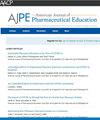Exploring the Role of LLMs Like ChatGPT in Pharmacy Education for Supporting Students' Therapeutic Decision-making
IF 3.8
4区 教育学
Q1 EDUCATION, SCIENTIFIC DISCIPLINES
引用次数: 0
Abstract
Objective
The aim of this study was to evaluate the utility of large-scale language models as training strategies for clinical student pharmacists, exploring their potential use in drug dosage adjustment while analyzing their limitations.
Methods
ChatGPT, Gemini, and Copilot were evaluated for predicting the appropriate drug dose using common pharmacokinetic problems. Three narrow therapeutic drugs—tacrolimus, vancomycin, and lidocaine—were selected, and 3 different therapeutic scenarios were tested for each drug with the models. The prompt structure was modified to analyze its impact on the results achieved. The performance of the models in each scenario was rated using a numerical scale from 0 to 2. The potential benefits of the model as support tools for students, as well as the identification of the current limitations, were evaluated.
Results
ChatGPT achieved the highest score and had the greatest number of correct answers. Tacrolimus inputs produced the most correct answers, likely because its calculations were less complex. Moreover, modifications in the prompt structure led to significant changes in the results for most models, highlighting the critical role of prompt design.
Conclusion
While the results indicate room for improvement, the successful cases highlight promising directions. With more rigorous study of the models, enhanced data quality, and a deeper understanding of prompt design, these artificial intelligence tools could offer substantial support to students. Educating users on these emerging technologies will further enhance their application in health care, maximizing benefits and mitigating potential risks and limitations.
探讨ChatGPT等法学硕士在药学教育中支持学生治疗决策的作用。
目的:本研究旨在评估大规模语言模型(LLMs)作为临床药学专业学生培训策略的有效性,探讨其在药物剂量调整中的潜在应用,同时分析其局限性。方法:利用常见的药代动力学问题,探讨ChatGPT、Gemini和Copilot预测合适的药物剂量。他们选择了三种狭窄的治疗药物——他克莫司、万古霉素和利多卡因,并用这些模型测试了每种药物的三种不同的治疗方案。对提示符结构进行了修改,以分析其对实现结果的影响。使用从0到2的数值刻度对每个场景中的模型的性能进行评级。评估了该模型作为学生支持工具的潜在好处,以及该模型当前局限性的识别。结果:ChatGPT得分最高;也有最多的正确答案。他克莫司的输入产生了最正确的答案,可能是因为它的计算不那么复杂。此外,提示符结构的修改导致大多数模型的结果发生了显著变化,凸显了提示符设计的关键作用。结论:虽然结果表明了改进的空间,但成功的案例突出了有希望的方向。随着对模型的更严格研究、数据质量的提高以及对提示设计的更深入理解,这些人工智能工具可以为学生提供实质性的支持。教育用户了解这些新兴技术将进一步加强它们在医疗保健领域的应用,最大限度地提高效益,减少潜在风险和限制。
本文章由计算机程序翻译,如有差异,请以英文原文为准。
求助全文
约1分钟内获得全文
求助全文
来源期刊
CiteScore
4.30
自引率
15.20%
发文量
114
期刊介绍:
The Journal accepts unsolicited manuscripts that have not been published and are not under consideration for publication elsewhere. The Journal only considers material related to pharmaceutical education for publication. Authors must prepare manuscripts to conform to the Journal style (Author Instructions). All manuscripts are subject to peer review and approval by the editor prior to acceptance for publication. Reviewers are assigned by the editor with the advice of the editorial board as needed. Manuscripts are submitted and processed online (Submit a Manuscript) using Editorial Manager, an online manuscript tracking system that facilitates communication between the editorial office, editor, associate editors, reviewers, and authors.
After a manuscript is accepted, it is scheduled for publication in an upcoming issue of the Journal. All manuscripts are formatted and copyedited, and returned to the author for review and approval of the changes. Approximately 2 weeks prior to publication, the author receives an electronic proof of the article for final review and approval. Authors are not assessed page charges for publication.

 求助内容:
求助内容: 应助结果提醒方式:
应助结果提醒方式:


